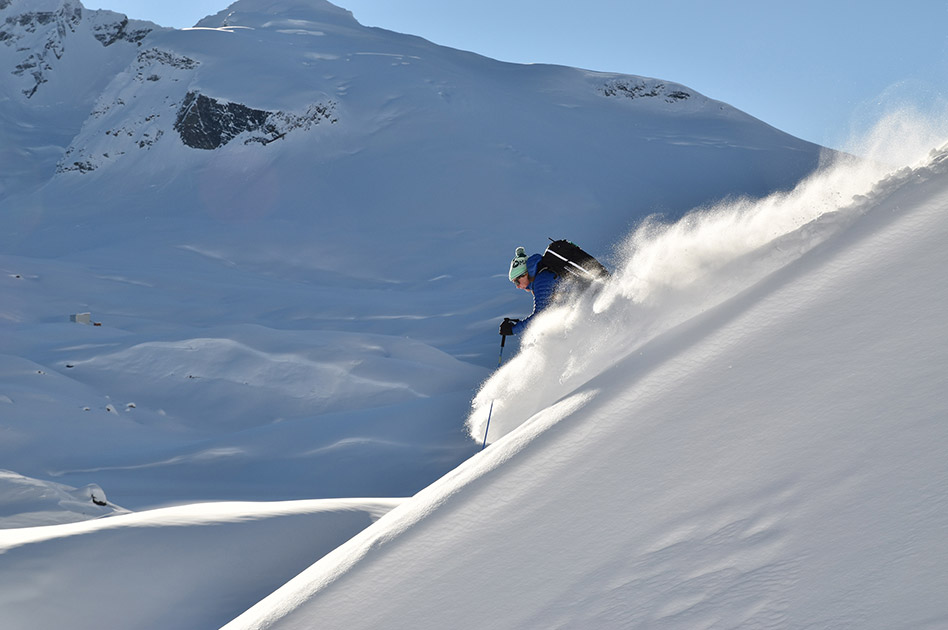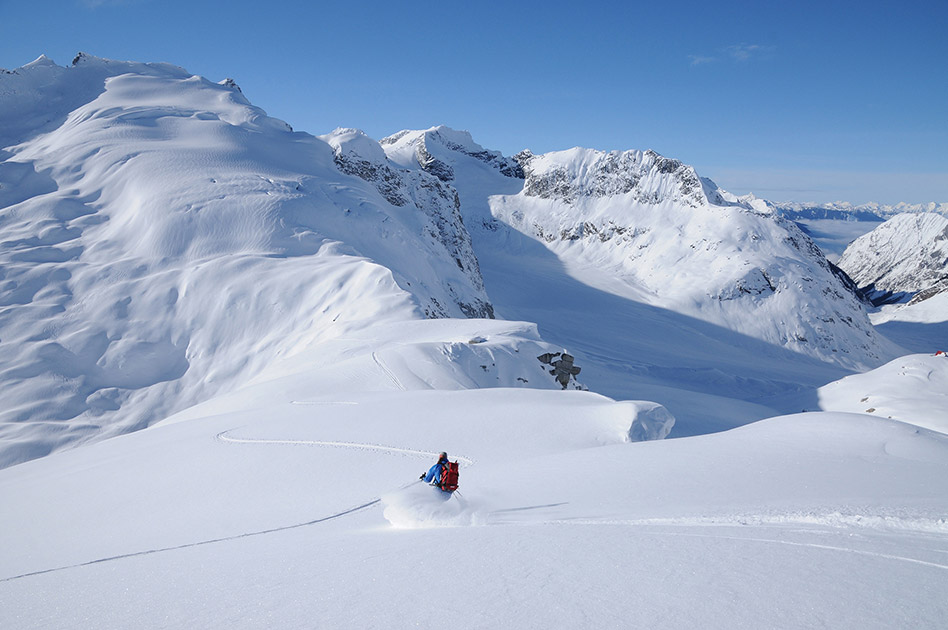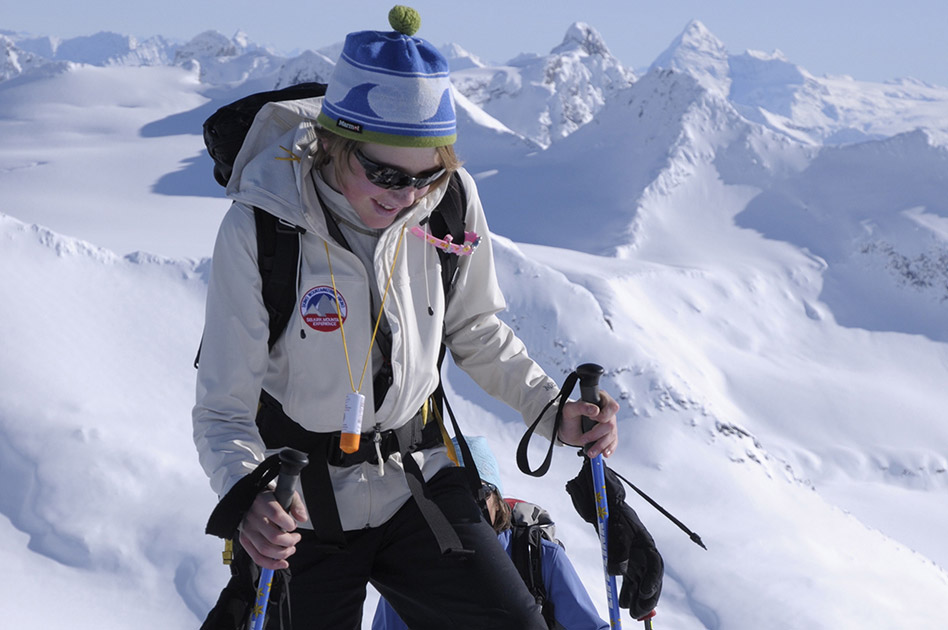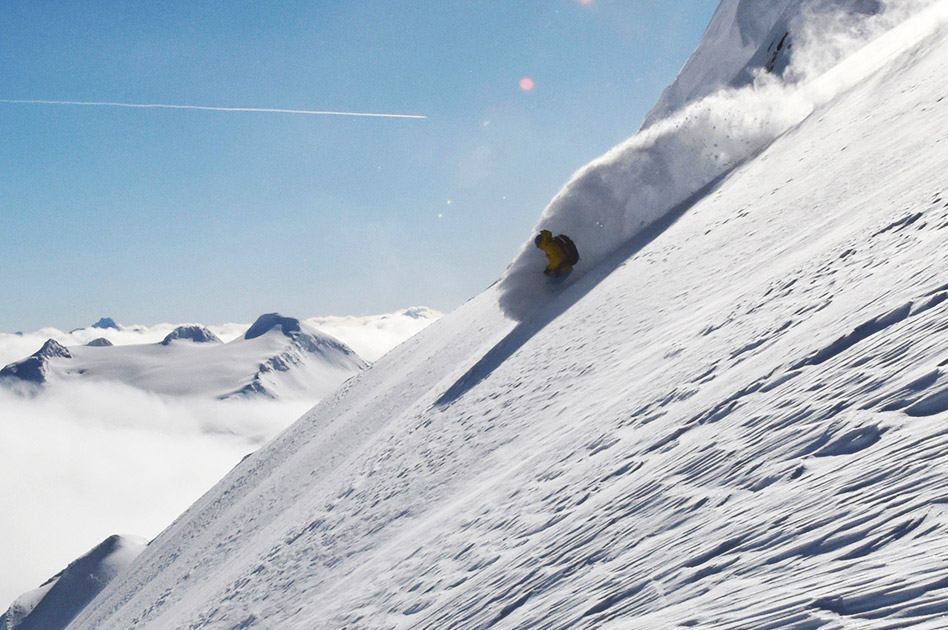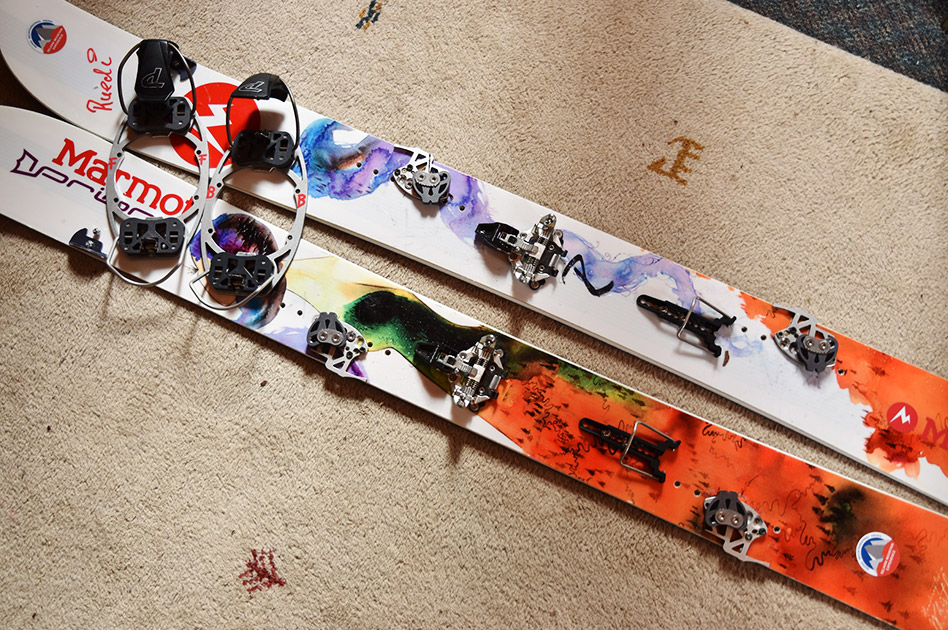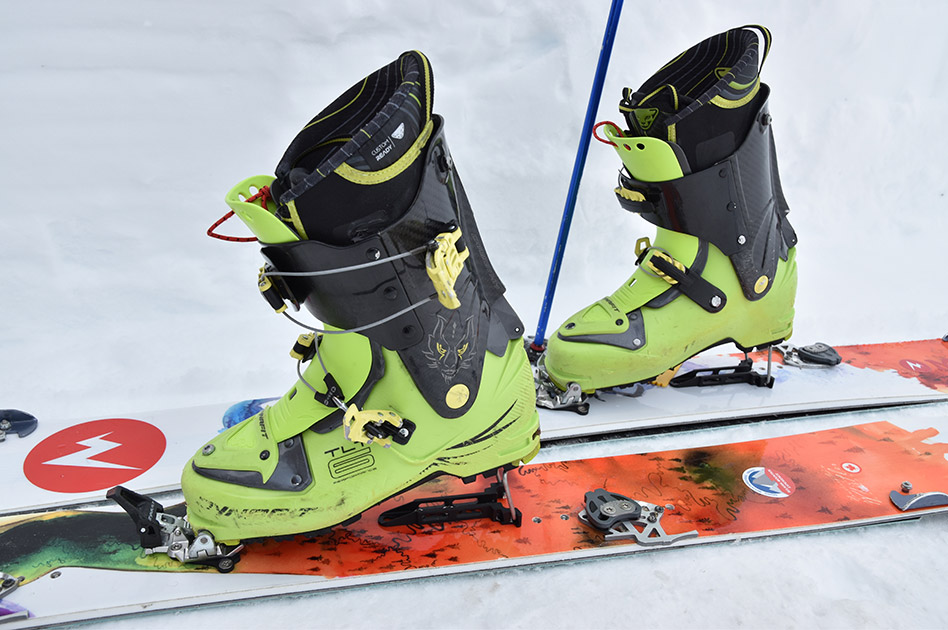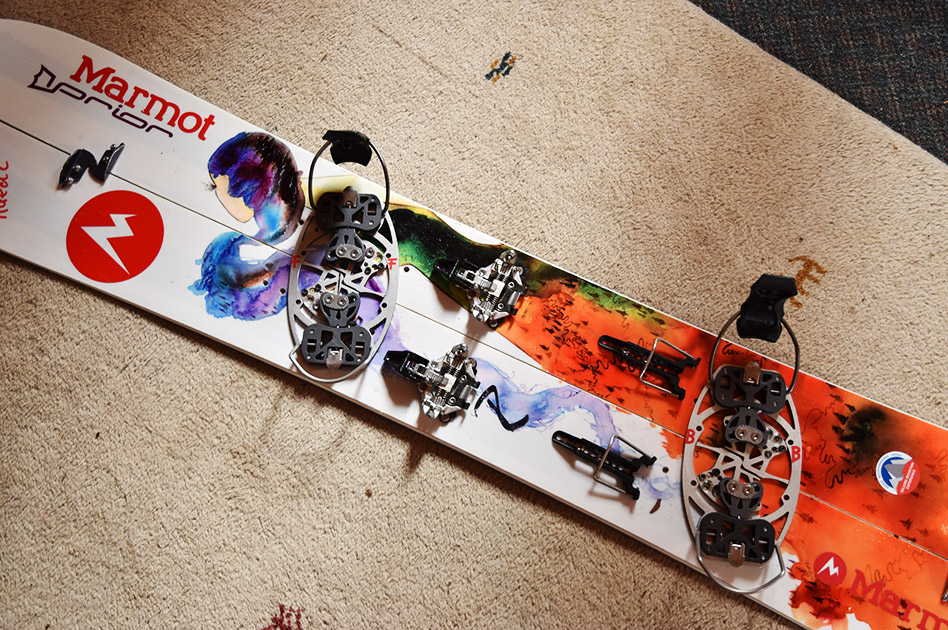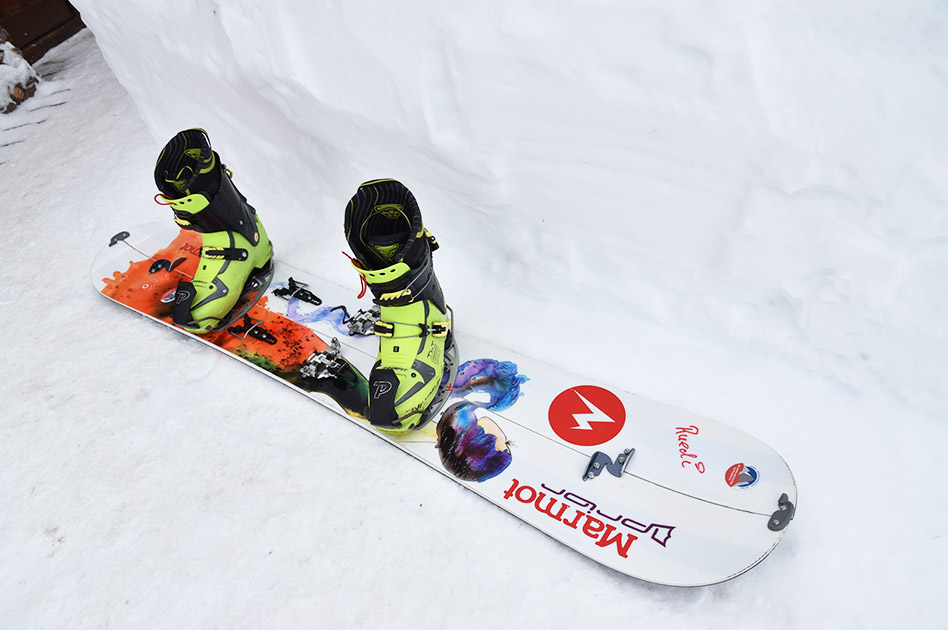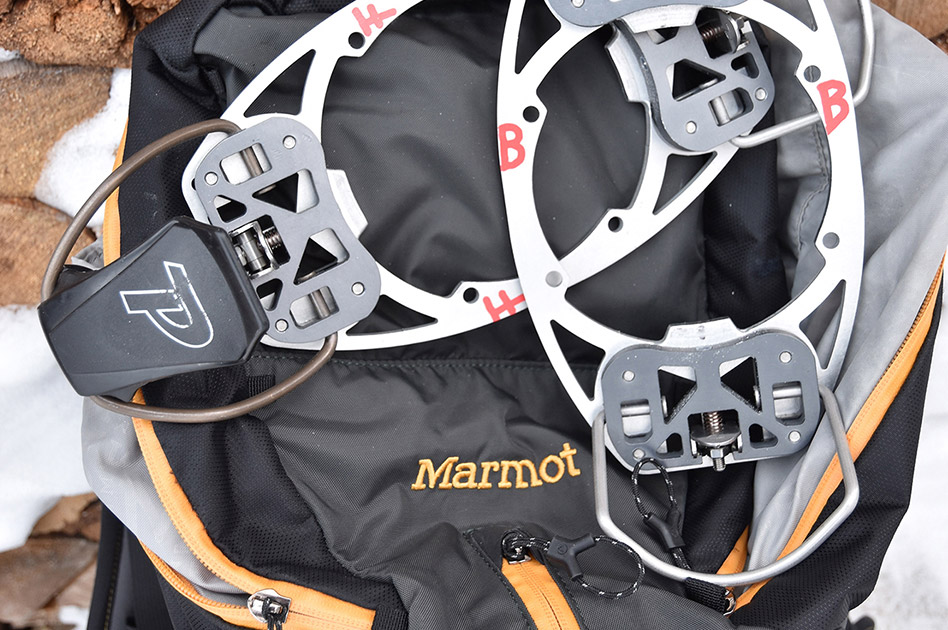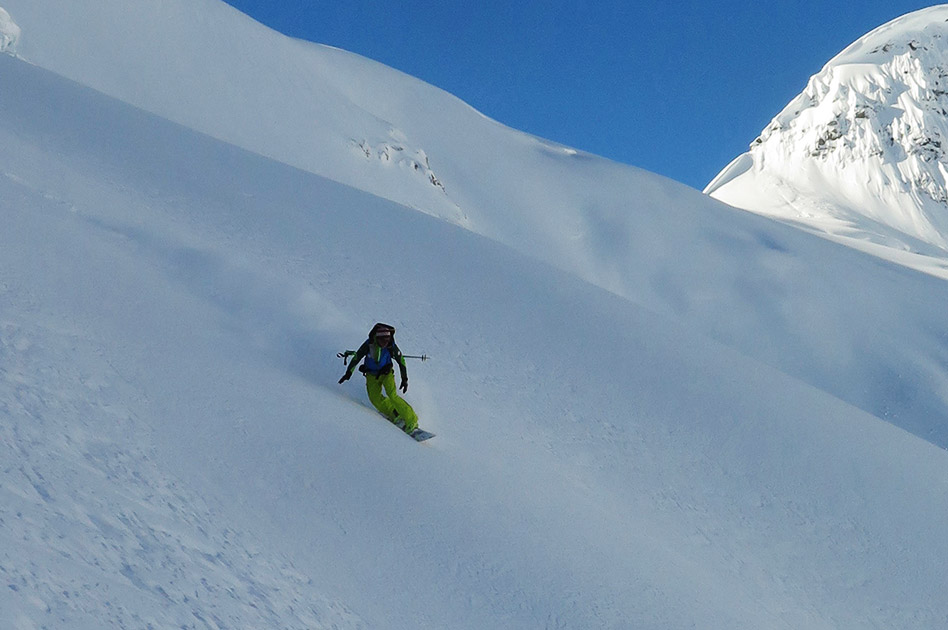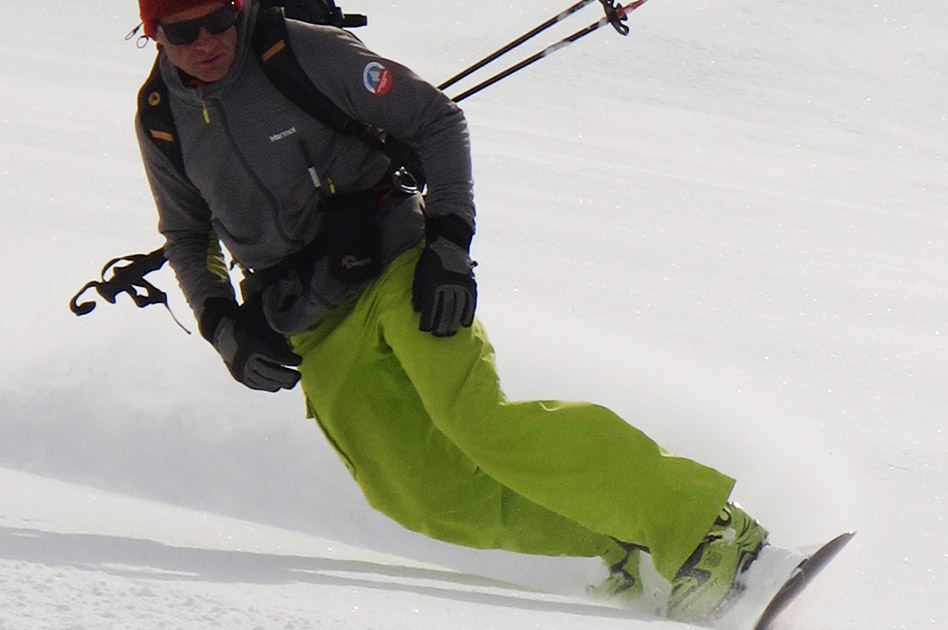From our Experience
For powder-snow skiing, ski mountaineering or snowboard mountaineering on alpine touring or on a split board it is most important to use equipment that work.
Alpine Touring Equipment
A semi-wide ski is more preferable over narrow skis or super-wide powder-skis. We recommend skis that measure a minimum 94 mm but a maximum of 110 mm under foot (most ideal is 100 mm to 107 mm). This allows you to ski on slightly shorter skis. Skiing in complicated terrain with deep snow on shorter mid-width skis is much easier and also more fun. We suggest that your skis are equipped with full release bindings and with ski-brakes.
We do recommend that you are not using heavy “free-ride” bindings. These bindings are great for slack-country skiing near a ski area, however they are definitely not meant for large terrain ski touring, where you walk several thousand vertical feet every day. The main reason is that these bindings are by far too heavy for daily ski touring and are too difficult to handle during long ski touring days and in stormy weather conditions.
In respect of skis, it is a fair question regarding the use of full camber skis or skis with a reversed camber. Both type of skis work well. However skis with reversed camber are more difficult for climbing, in particular in hard-pack trails or in steep complex terrain. In such situations skis with a full camber provide more positive traction and make climbing much easier. When it comes to skiing down, then it is a matter of personal preference. For most skiers I don’t think it makes a big difference if full camber skis or skis with reversed camber. Skiers who are technically less strong might be able to maneuver a ski with reversed camber much better than skis with full camber. For skiers who enjoy skiing fast, a full camber ski will provide a more stable and positive ride.
Guests who prefer skiing on alpine touring gear and who plan to purchase equipment, we recommend buying an easy to use lightweight binding with a good walking function. The binding we recommend as the perfect touring binding is the Dynafit TLT Radical 2.0. It can be found in many specialized ski-touring shops.
Climbing skins should be self-adhesive skins with a tail hook. If you need to buy new skins then maybe you want to look into a mix-hair skin with low angle weave of the hair onto the blush. This will provide better glide and a stronger grip while climbing. The skins we made the best experience with is the Pamocca and the Dynafit skin. Pamocca makes both skins.
Ski boots have to be special ski-touring boots. These boots have a proper rubber sole for safety while walking on hard-pack snow or in rocks, come with a ski-touring walk mode and with a downhill skiing mode. In additions ski-touring boots are much more comfortable, warmer and lighter than downhill ski boots. At Durand Glacier, all Guides and Staff use Dynafit boots. This mostly because Dynafit does build ski-touring boots that provide not just highest quality boots but also have the largest range of walking verses down-hill skiing mode of all ski-boot manufacturers.
If you're skis / bindings / skins do not fit the above description then we recommend that you rent from our special "powder ski-touring" rental pool, available at the Durrand Glacier Chalet.
Splitboard Touring or Mountaineering
The number of snowboarders who want to enjoy the backcountry is growing each year. While the easiest way for a snowboarder to travel and ride in the backcountry is on a splitboard with soft boot splitboard bindings, I advise snowboarders to take a fresh look at splitboarding.
Often when we get snowboarders at the Durrand Glacier Chalet on a splitboard, I end up helping them with the proper technique for touring and snowboarding in complicated large alpine terrain. This is not just something I view as part of my job as an experienced mountain guide and big mountain terrain snowboarder and skier, but it is also something I truly enjoy doing. After all, we are a very small family of enthusiastic skiers and boarders and we should help each other, passing on our experience.
It all starts with the proper equipment. Typical snowboard ratchet strap style bindings and soft boots are what most snowboarders use inbounds. Snowboarders on a splitboard and touring in large alpine terrain is different and requires different equipment.
What do we recommend?
Here’s where I recommend a fresh look and consider what kind of boot is best suited for the backcountry. Currently there are several ski boots on the market that are designed for ski-touring that provides maximum walking flex/rotation and connects to the touring mechanism at the toe which all combined offer a very efficient method of uphill travel. Fortunately for splitboarders, these boots are usually not as supportive as typical downhill ski boots and can be easily modified to flex and feel more like a snowboard boot.
The ski-touring boot I like most is the Dynafit TLT Mountain. The TLT Mountain is not only one of the lightest boot on the market; it also has the greatest walking flex of any ski-touring boot. The downhill ski mode can be adjusted to be more supportive or less supportive. Most splitboarders make some minor adjustments to their boot with a few common ones being:
- Some riders like to keep all the high back support the boot will give them but want to provide a little forward give in the boot before initiating a toe side turn. In this case they increase the size of the “Forward Lean Insert Hole”, located inside the back of the ski-boot cuff.
- Alternatively, the cuff locking tab can be cut off completely. This way the top buckle, when closed, can’t lock in and change the boot into a stiff down-hill ski-touring boot. By cutting off this knob, the Dynafit TLT 6 boot will ride much softer and provides needed flex.
- Removal of the power strap and for more softness of the boot you can also remove the booster tongue. However, if you prefer a more damping forward lean softness of the boot then you might want to keep the booster tongue in place. This is what I do.
The next step is the binding. Again, comfort, efficiency and weight is essential. The Phantom splitboard binding offers all three criterions. This binding was designed specifically for splitboarding with a ski-touring boot. It puts the boot as close to the board top sheet as possible and transfers power directly to the top sheet while still allowing the board to flex naturally without producing the dead spots. It is incredibly well and cleanly built and is designed with high quality material and parts. It is easy to use and is very efficient when it comes to splitboard mountaineering.
While walking up-hill, the binding can be easily taken off the splitboard and be put into the back-pack. Each splitboard half is connected to the Dynafit TLT 6 boot by stepping into a Dynafit TLT toe binding that is mounted on the board.
This entire system bolts directly to any factory splitboard and requires no special tools or drilling.
Benefits of this splitboard system
- Lightweight
- Ski-touring boots are warm and can be formed to the feet if needed
- Ski-touring boots can be equipped with proper boot crampons if needed
- Safe and much easier walking on frozen snow, hard-pack snow and rocks with ski-touring boots
- Ski-touring boots provide much safer and more positive touring on the splitboard and are much less bulky
- Riding in deep powder or large alpine terrain is as good as in soft boots, no performance loss when boot modification is done
- The Phantom splitboard system is much lighter and more durable and reliable than soft-bindings
- The ride feeling is very repeatable as boot buckles setting can be set the same each time and the bindings lock onto the boot in exactly the same way every time via metal bails.
- Most important, in case of an avalanche, it is extremely fast and easy to step out of the binding (pull the front bail of the binding and the board is gone)
Forward stance on the split-board
I recommend the stance on the splitboard should be steeper than what riders might like to have while boarding in ski areas. For example, I use 26˚ front and 16˚ back. This gives me the following benefits.
- More drive on the board
- I can double pole across flat sections of the mountains with less energy
- Less twisting of the body and knees while double poling across a dip or flat sections, reducing stress in lower back and in knees
- Makes long downhill traverses with a back-pack much easier
Walking up
- Dress lightly. Not over-dressing is key
- Have your boots in full walking mode
- Ski poles adjusted for walking, not too short or too long. When you turn the poles around and hold them directly below the basket with the handle touching the surface of the board, having the lower arm perfectly level, then you have the best length for your poles for walking uphill.
- While walking in steep terrain you might hold the lower pole on the handle and the up-hill pole slightly below the handle.
- Lock your ski-boots into the toe-peace of the Dynafit TLT system, depending on incline use or don’t use the heel-risers
- In hard-pack or frozen snow conditions attach the ski-crampons to the board. The Dynafit 125 mm ski-crampon is well built and provides very positive support in steep frozen slopes. It attaches to the Dynafit TLT toe-piece.
- The riding interface of the Phantom splitboard binding can be carried in the backpack; it adds very little weight to your pack.
- You will be amazed how much easier you are going with this system.
Riding down
- Step out of the the Dynafit toe piece. The toe piece stays mounted on the board.
- Remove skins from each half of the splitboard.
- Use a small scraper to clean the board from any snow/ice stuck on the base of the board from the skins, the inner edge and the board surface, particularly around the binding.
- Put the board together and lock on the bindings.
- Slightly tighten the top buckle of the ski boots.
- The lower buckle should be snug but not too tight.
- Lengthen your ski poles. I have my poles at 123 cm for walking and 135 cm for riding. I do not recommend collapsing the ski poles and strapping them to the pack. Instead, keep them in your backhand or slide them in between the backpack and your back. This allows you to have the ski poles at any time handy, in particular if you approach a traverse or a flat section where you like to maintain speed and momentum.
Enjoy your powder day
Ruedi Beglinger


